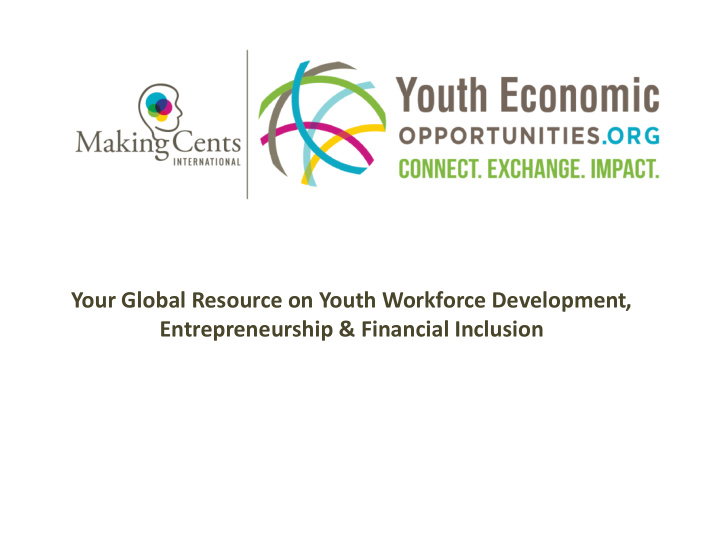



Your Global Resource on Youth Workforce Development, Entrepreneurship & Financial Inclusion
Banking on Change: The Youth Savings Group Model Making Cents International 23 March 2016
Banking on Change Overview
Tackling Financial Exclusion • Today, about 2 billion people are financially excluded • Access to savings, bank accounts and credit can enable individuals to invest in small businesses and increase household income • Banking on Change’s savings -led approach to microfinance aims to reduce poverty, increase social equality and encourage economic growth, as well as build the business case for linking informal savings groups to formal financial services 4
A savings-led approach to financial inclusion Informal Financial Financial Exclusion Formal Financial Inclusion Inclusion Step 2 Step 1 Step 3 • • • Identify the most Access to informal Provide Bank Literacy financial excluded financial services; and Linkage training individuals and group-based financial • Access to demand- communities- with a transactions driven savings focus on young people • Provide in-depth products • Organise into groups enterprise training to • In time, access to and build capacity support income demand-driven through training in generating activities overdraft products group processes and financial literacy
Key achievements 6-Year Stats Phase 2 Stats 418,016 savings groups 755,000 people have been members have been supported supported 36,000 savings groups have 307,605 of these savings been formed groups members are youth 4,132 groups linked to a 11,725 youth savings groups formal financial institution, have been established more than half to Barclays 116,908 income-generating 73% of savings group activities have been started members are women 695 Barclays employees have engaged with groups through skills-based volunteering
The Banking on Change Youth Savings Group Model (YSGM) The Need
Overview: the Need for a YSGM Young people don’t join traditional VSLAs (18% U25 in BoC1) Young people are more financially excluded They are also much more likely to be unemployed (x3 – ILO) And there’s a global youth bulge ( SSA: 63% U25) YSGs help tackle these challenges – but needs global effort Hence the Banking on Change Youth Savings Group Model • A ‘How To’ Guide based on 11,500 YSGs + peer consultation • Our ambition is to scale the use of YSGs to support youth economic empowerment 8
Youth Financial Exclusion 35% 33.1% 30% 27.5% 25% 20.5% 20% 17.0% 2011 2014 15% 10% 5% 0% Account at a financial institution, adults (25+) Account at a financial institution, youth (15-24) 9
The Youth ‘Bulge’ 100% 90% 37% 80% 40% 54% 57% 70% 72% 60% 20% 50% 20% 25+ 40% 15 - 24 17% 17% 0-14 30% 12% 43% 20% 40% 28% 26% 10% 16% 0% World More Less developed Least Sub-Saharan developed regions developed Africa regions countries 10
The Banking on Change Youth Savings Group Model (YSGM) The Principles
YSGM Principles • TARGETING AND FORMING YSGs A • SUPPORTING YSGs FOR SOCIAL & ECONOMIC EMPOWERMENT B • SCALING & SUSTAINING YSGs C 12
New YSG members recruited – comparison over 18 months 90,000 80,000 70,000 60,000 50,000 40,000 30,000 20,000 10,000 0 July - Dec 2013 Jan - June 2014 July - Dec 2014 Young People can save… but adapt Outreach Approach 13
“ “I have been in many savings associations before, but the Youth Saving Group has more additional training which enables me to know how to manage my expenses and also keep separate records of all my businesses. This helped me know which of my businesses is making more profits or losses. I used not to keep records and put all my monies into one bag without separating them .” Banking on Change Enterprise Your Life Specialist Focus Group Discussions Youth Curriculum / Approach 14
Linking to a formal financial institution can be a logical and attractive next step for YSGs. 15
The Banking on Change Youth Savings Group Model (YSGM) Experience from the field – Stella Tungaraza
How did we mobilize youth to form groups? Use of adult SGs to mobilize youth Creation of child/youth trainers’ teams Use of young field officers Integration with Plan’s youth programs such as ‘because I am a girl’ 17
In Tanzania we targeted youth aged 25-35 but included younger youth too. We wanted youth engaged in or wanting to start IGAs. Important questions: 2,527 8% How young? 4,465 13% Where are they? 25-35 female youth 15-24 female youth What are they engaged in? 25-35 male youth 5,564 15-24 male youth 20,469 17% 62% 18
In Tanzania we focused on: EYL – ENTERPRISE YOUR LIFE 1800 1600 1400 1200 Total Number of Groups 1000 Number of Groups received 800 EYL 600 400 200 0 Total Number of Number of Groups Groups received EYL 19
USE OF CTs: Tanzania has approximately 120 youth CTs that are community based and paid by groups. Over 60 new groups have been formed since end of December 2015 when the project officially ended. LINKING TO IMAs – About 30% of YSGs are members of IMAs. The IMA provides groups with savings, loans and insurance. LINKING TO TPB – Example of Muungano IMA with 6 YSGs and 158 members all linked to TPB. The members can operate their individual accounts independent of the group but they can also buy shares, receive and repay loans via their accounts using mobile phone. 20
Thank you! Any Questions?
Call for Proposals for the Global Youth Economic Opportunities Summit | Deadline March 25: http://www.youtheosummit.org/#!call-for-proposals/cxo4 10 th Anniversary Global Youth Economic Opportunities Summit | September 28-30, 2016 | Washington DC: http://www.youtheosummit.org/ Stay up to date on the latest Youth Economic Opportunities resources, events and news with www.YouthEconomicOpportunitites.org. 22
Recommend
More recommend